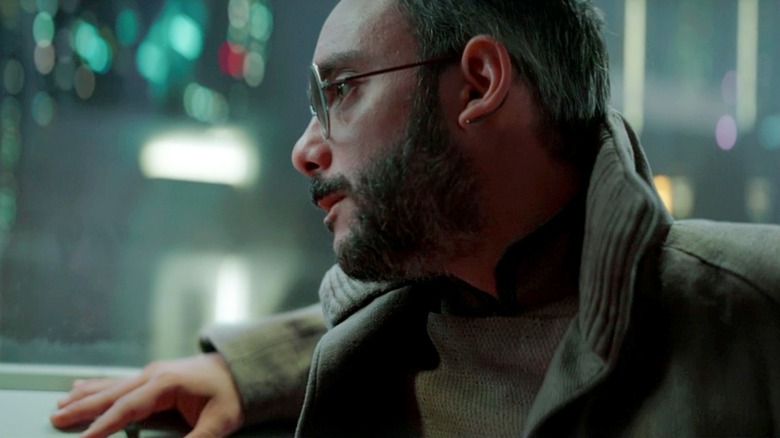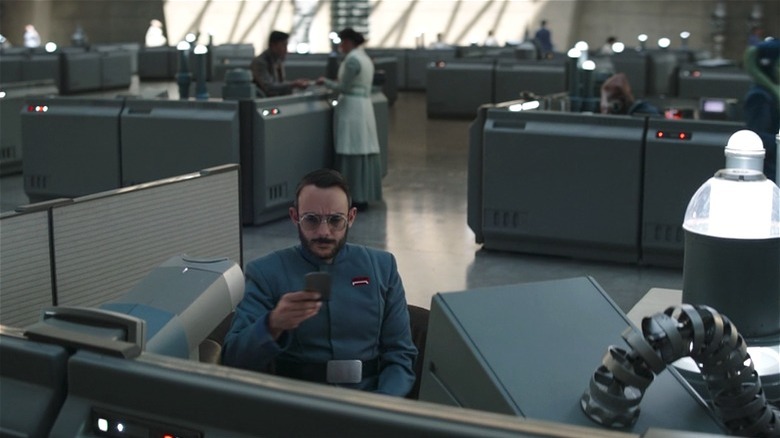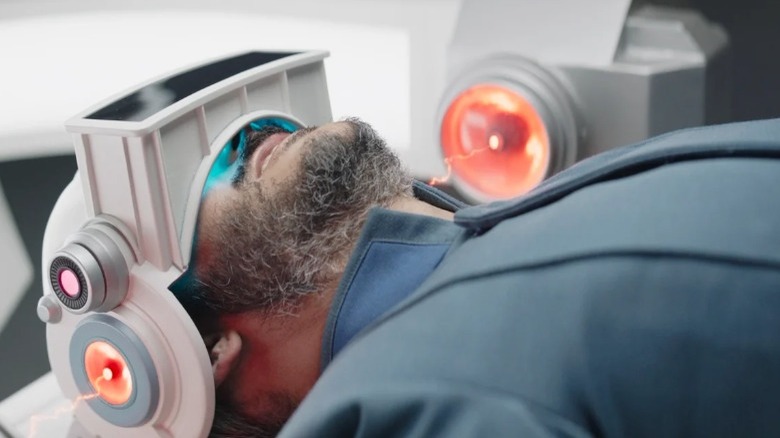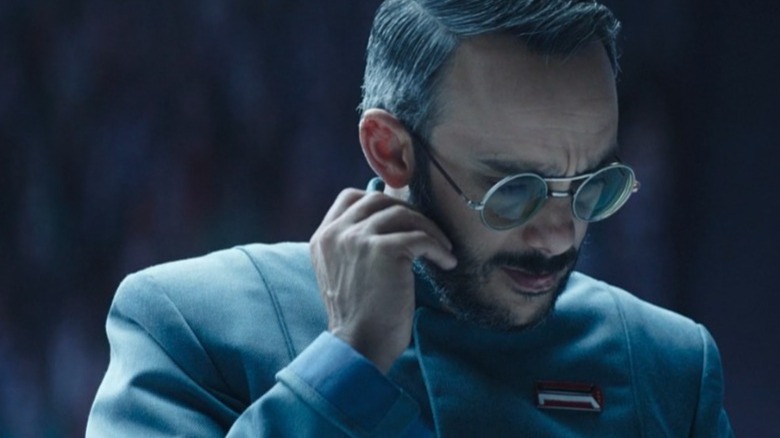On Coruscant, The New Republic Looks A Lot Like The Galactic Empire
This post contains spoilers for season 3 of "The Mandalorian" and the first season of "Andor."
In the latest episode of "The Mandalorian," titled "The Convert," things take a serious turn in the ecumenopolis of Coruscant. Shifting the tone and tint of the usual storylines that follow Din (Pedro Pascal), and now Bo-Katan (Katee Sackhoff), the episode hones in on the immediate aftermath of the New Republic overthrowing the Empire, and this transition is not as smooth as one would hope.
By bringing back former Imperial scientist Penn Pershing (Omid Abtahi), "The Mandalorian" sets up parallels between the new regime on Coruscant and the standard aspects of Imperial rule, the latter being previously explored in considerable detail in Tony Gilroy's "Andor." While the aesthetic similarities between the two regimes are deliberate, the episode points towards a troubling overlap between New Republic and Imperial sensibilities, especially when it comes to indoctrination techniques and ideological conversion.
While the title of the latest episode exclusively alludes to Bo-Katan's inadvertent conversion into an honorary member of The Children of the Watch, it also refers to Pershing's fresh conversion to a new regime and way of life. Shedding his Imperial ways, Pershing is eager to be useful to the New Republic but is seen struggling with his purpose when he is not allowed to further his cloning and genetic engineering research. This sets the stage for a reversal of roles, where Pershing is at the receiving end of inhumane experimentation, which might or might not have killed him, thanks to Elia Kane's (Katy M. O'Brian) covert machinations.
Rude betrayal aside, we are privy to the dark underbelly of a burgeoning regime that is forced to rise and adapt quickly to rapidly changing moral parameters amid promises of freedom and a new age.
Aristocracy and bureaucracy
"Andor" dives headfirst into the ins and outs of aristocratic and bureaucratic settings with the respective storylines of Mon Mothma and Syril Karn. As the show exposes the inner workings of the imperialist machine, we are alerted to the corruptive rot at the heart of the Empire's bureaucratic branch, which seeps into the Senate and those who are a part of aristocratic society.
While Mothma's allegiances lie with the Rebellion, and she needs to put on a mask at all times, those around her either indulge in ignorance or a sheer lack of spine, as their wealth and social status shield them from the evils of the Empire. As long as they are compliant and do nothing about it, they are safe — a sentiment echoed in the aristocrats who speak with Pershing, who blatantly state that they would rather not get involved, no matter who is in control.
On the bureaucratic front, we follow Karn extensively in "Andor," and we see his living conditions, along with his workspace after he botches the mission on Ferrix. The show fleshes out the workings of cold, corporate bureaucracy, where officials like Dedra Meero are not above corporate sabotage and social climbing, as long as they emerge at the top. While the bureaucratic office spaces in "The Mandalorian" do not uphold fascist ideals, they aesthetically mimic the same layouts that the Imperial office spaces did.
Even Pershing's living quarters are exactly like Karn's, hinting that the new regime has heavily repurposed Imperial ways of operation, although they seem to reject every Empire-sanctioned technology/idea on paper. The similarities do not end here: all rehabilitated Amnesty officials are given codenames, with frequent counseling meant to closely monitor their thought process, with the threat of being sent back to a re-education center looming ominously.
Brainwashing techniques
Once Pershing arrives at Amnesty Housing, he meets fellow former Imperials, who are all referred to by codenames, including Kane (called G-8). Pershing is L-52, and he is referred to as such throughout until he and Kane reveal their real names to each other mid-mission. The difference between being called by one's name and a designated codename is massive — the latter only serves to strip one of individual identity, further dehumanizing them into a cog that helps serve an infrastructural machine. Pershing feels his individuality chip away one day at a time, especially when he is forced to give up his lifelong research, which obviously grants him a sense of purpose (and lends to who he chooses to be as a person).
This dehumanizing technique is a key aspect in the Narkina 5 prison segment of "Andor," where inmates are stripped of autonomy to the point that they do not even bother telling their real names to each other. The implications of these methods in both cases are different — the new Republic does not have a fascist core and aims to integrate — but it is troubling that the new regime is closely following the methods employed by the very threat they have fought so hard to defeat. Whether this pattern is deliberate or subconscious is debatable.
Perhaps the scariest instance of infrastructural overlap is the Mind Flayer used on Pershing at the end of the episode. The Mind Flayer is a brainwashing and torture device used by Imperials, which is now being repurposed into an experimental treatment meant to "soothe" those unable to shake off Imperial indoctrination. Although posed as a "gentler" version of the Mind Flayer, the effects seem to be the same, as both methods are aimed at erasing autonomy to overwrite the mind with respective propaganda.
Shaky foundations
While "Andor" situates us at the height of the rebellion, whose spark is ignited with the Aldhani heist, "The Mandalorian" focuses on a shaky transitional period where the Empire is gradually fading and making way for a new era. The process of change is always uncomfortable and often ugly, especially when employed at a root level, as it affects key socio-political and cultural aspects of various societal strata. Class, power, and moral standing play a key role here — Pershing goes from an Imperial bureaucrat to a working-class one, and although many things have shifted, the shadow of Imperial workings still looms large. It is difficult to rid oneself of corrupt and intrusive methods of damage control overnight, but the manner in which Pershing's supposed betrayal of the new regime is handled is problematic as heck.
It is important to note that the New Republic is fairly new at helming this fresh era, as Chapter 15 of season 2, "The Believer," shows a still-functioning Imperial outpost with stormtroopers happily employed under the Empire. The motif of the Imperial travel-pack biscuits functions as a reminder of the small comforts of working under such a regime, which is remembered with almost a sense of nostalgia by the new converts. This is significant to the point that Kane uses a box of these biscuits to earn Pershing's trust, and munches on them after tampering with the Mind Flayer, revealing her true allegiances.
By masking their true intentions, pseudo-converts like Kane can wear the mask of compliance and order to introduce chaos in the long run, attempting to dismantle a new, shaky regime from the inside. All is not well, and shady disruptions await.
New episodes of "The Mandalorian" season 3 air every Wednesday on Disney+.



